What pitfalls are there?
It is not difficult to paint the tiles in the bathroom with your own hands, it is much more difficult to do it efficiently. To prevent the coating from cracking and peeling off the surface after a short period of time.
The first thing to consider is water resistance material. Even if you paint ordinary bathroom walls, it requires washable and super resistant paint, not to mention painting the tiles. You will find out which composition is best in the next section.
The next important nuance - smooth non-porous surface... Glazed ceramic tiles are not intended for painting - the paint will not be able to penetrate into it, which means that it will not hold firmly. Fortunately, there are special primers - they are suitable for non-porous glossy substrates, adhere firmly to the wall, and improve paint adhesion.
Take a look how best not to make repairs.
In the photo, repainting the colored tiles in white
The last important detail is easy care... Bathroom wall and floor coverings need to withstand more than just water ingress - they will have to be washed more often than others. In this case, savings in repairs can affect the quality and stability of the painted coating.
In the photo there are red walls in the bathroom
What can you paint?
50% of success when painting tiles lies in the choice of the right materials, 45% in high-quality preparation of the base and only 5% in the skills of the master. Let's start with the first and most important - the choice of paint.
Take a look ceiling painting instructions.
Oil paints
The cheapest remedy, known for a long time. Oil compositions are distinguished from others by the presence of a pungent odor: it is rather difficult to work with them, especially in a closed, unventilated space. But after drying, the smell does not remain, and the surface is a strong film that will remain unchanged for many years.
The colors of the paints are mostly factory-made, ready-made: but you can also tint yourself in the desired shade by choosing a can of white.
Important! Light shades can change in color over time, turn yellow: therefore, it is better to choose white and other neutral tones in the form of latex or epoxy paints.
Latex paints
Latex is a pure polymer that is waterproof and highly flexible. Paints containing rubber additives have the same characteristics: they do not allow water to pass through, they are easy to clean, they hide cracks and small surface defects.
Despite the "rubberized" texture, latex paints breathe, which means they will be able to maintain a microclimate in the bathroom. True, there are also disadvantages: on the surface it can form mold and fungus. Another drawback is low resistance to light, so if the room has window, it is better to choose a non-fading epoxy enamel.
In the photo, a variant of latex paint
Epoxy paints
The strongest and most durable option is epoxy. It has the properties of a resin, only easier to use.Although it is impossible to call the application of paint easy - if you need a really high-quality result, entrust the work to professionals who already have experience with epoxy.
Lying down on ceramic tiles, epoxy paint creates a waterproof, fireproof, resistant to mechanical abrasion and fading plane.
How to paint with your own hands?
When the enamel that is suitable for the price and quality is selected, you can paint! But before starting work, you need to prepare everything you need. In addition to the paint can itself, you will need:
- protective film to cover furniture, plumbing;
- masking tape (we will use it to protect joints with the ceiling, floor, countertop);
- brush + roller or airbrush (tools are selected depending on your skills);
- cuvette to the size of the roller;
- grout to prepare the joints for painting;
- acrylic or other primer on non-porous surfaces;
- varnish, if additional protection of the finish is required.
In addition, arm yourself with protective gloves, a respirator (if you work with strong-smelling compounds) and a solvent - they can quickly remove the paint if you accidentally stain the room or smear yourself.
Step-by-step instruction
In any finishing work, the preparation stage is almost key: the beauty of the application, the service life of the paint and other important characteristics will depend on how well you prepare the ceramic tiles.
The preparatory stage includes:
- Cleansing... Just washing with a damp cloth is not enough - you need to clean off dirt, mold, mildew, and wash off the dust. Use special formulations such as bathroom gels or powders.
- Sanding... On an overly glossy glazed tile, paint, even with a special primer, will not fall in the best way. To improve grip, run over the surface with sandpaper.
- Grouting... Special attention should be paid to the seams - clean them with a brush, tap them, remove the chipping elements. Get a fresh grout and renew the spaces between the tiles, let dry.
- Protection... Time for masking tape - glue all the joints that need to be secured with it - with the ceiling, floor, walls, plumbing, furniture.
- Degreasing... In order for all further layers to hold better, the preliminary coating should not only be dust-free, but also degreased. Ordinary solvents or industrial alcohol will work.
- Primer... The final preparatory stage - with a roller or brush, spread a thin layer of primer over the entire surface. Leave to dry, the time is indicated on the package.
In the photo, painting the wall with a roller
It's about time apply paint... This simple business also has certain tricks:
- Choose a tool... Brushes often do not work well - they leave marks, it is almost impossible to make an even coating with them. Not everyone knows how to use an airbrush. Therefore, the best option would be a roller, in addition to which they take a small brush for corners and hard-to-reach surfaces.
Important! Rollers are different, choose the right one for your paintwork. Consider humidity and temperature. Usually, the packaging indicates the conditions in which it is best to work.
- Start with corners and seams... Use a small brush to paint over all corners and hard-to-reach places, and then roll up the main area with a roller.
- Move from the top corner... Always start to paint from the top, gradually going down to the lowest point.
- Let the surface dry... This applies to both the time between layers (at least two layers will have to be applied), and the period of complete drying - you cannot wash at this time.
The last step apply protective varnish (if used) and remove masking tape.
Video
See the instructions on how to quickly and on a budget to update the interior of an old bathroom by painting the tiles on the walls and floor:
In this video, you will find step-by-step instructions for painting old tiles:
Beautiful examples for inspiration
The easiest option is to cover the tiles with an even, uniform layer, but if you want to create an original design, use stencils. This idea is simple and inexpensive, and there are a great variety of patterns in stores - from colors and geometry to children's drawings.
If you have an artistic talent, you can do without a stencil, simply by depicting any motive you like on the walls.
Another easy way is a repeating print. Dashes, dots, stars, stripes are easy to draw on the tile yourself.
In the photo, the result of using stencils on the floor
Approach the repainting of the tile with all responsibility, prepare the tile and use high-quality paint - then your work will last for many years.

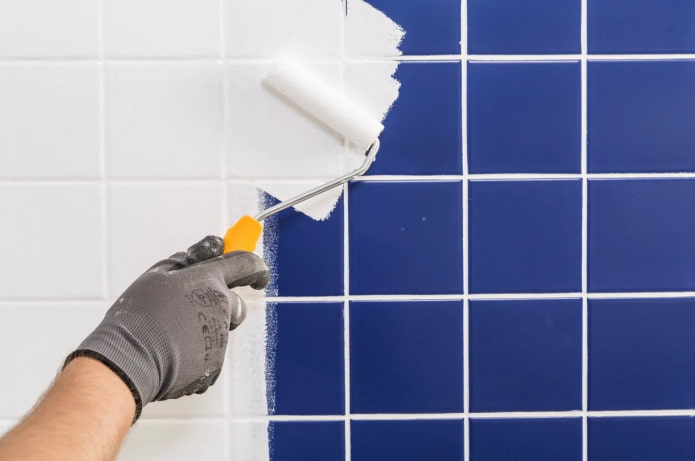
 10 practical tips for arranging a small kitchen in the country
10 practical tips for arranging a small kitchen in the country
 12 simple ideas for a small garden that will make it visually spacious
12 simple ideas for a small garden that will make it visually spacious
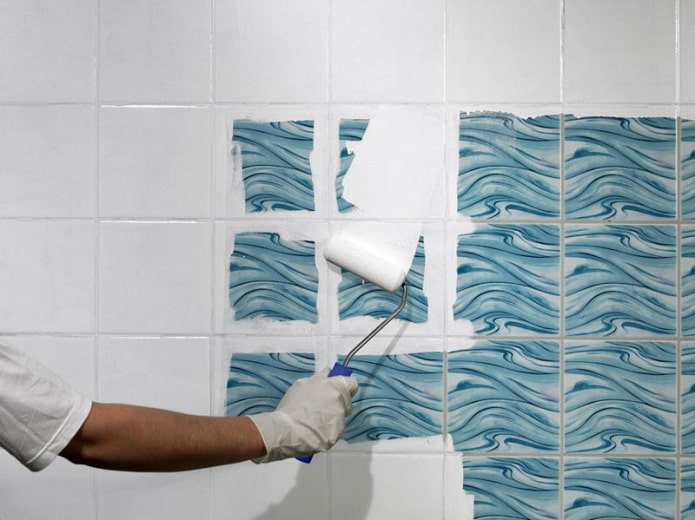
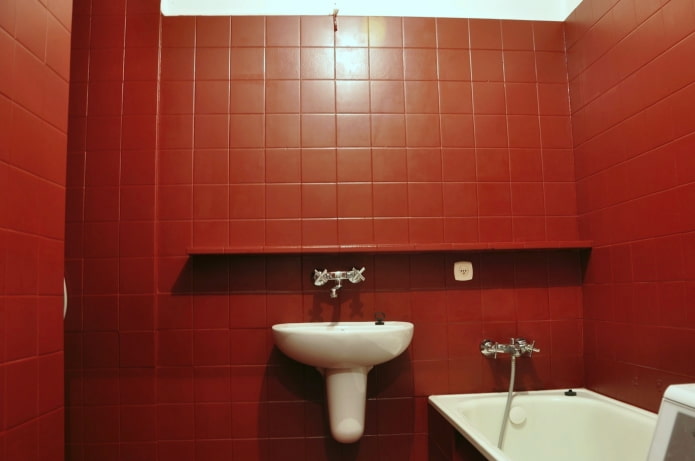
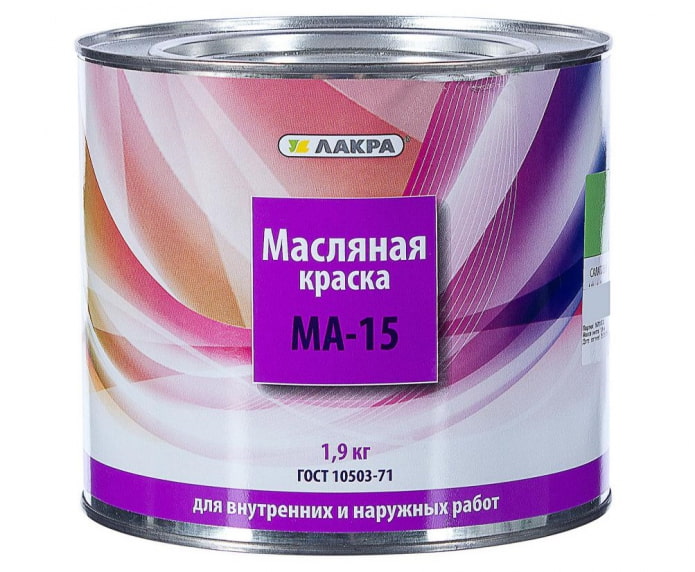
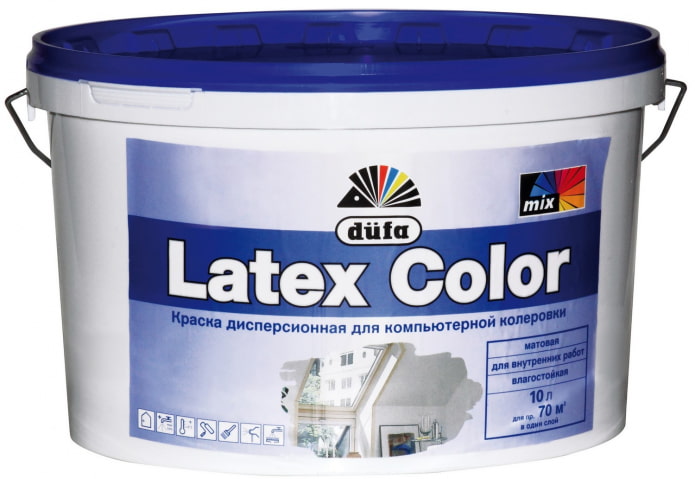
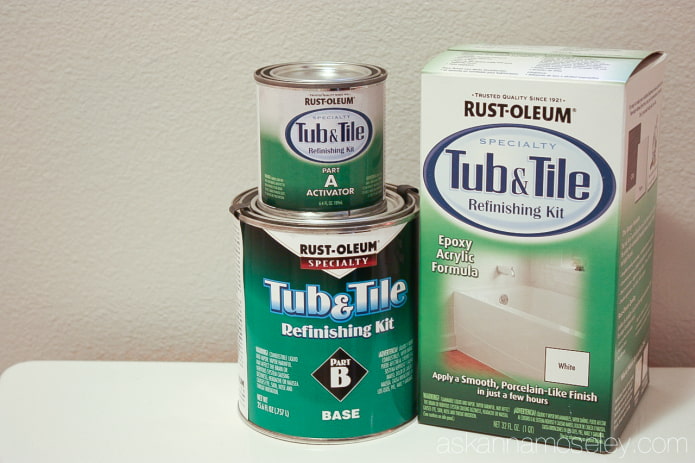
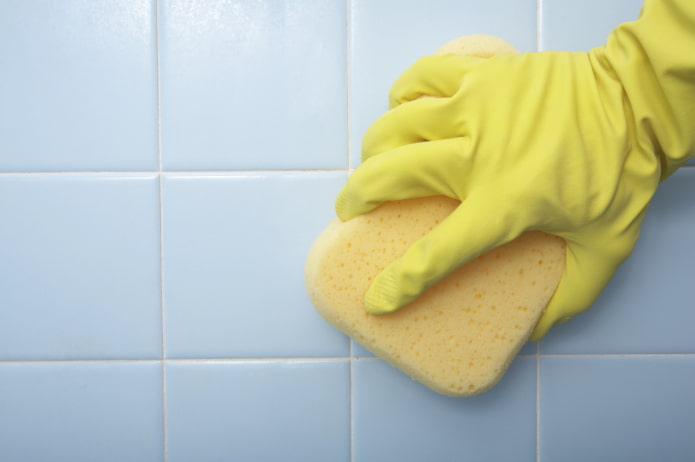
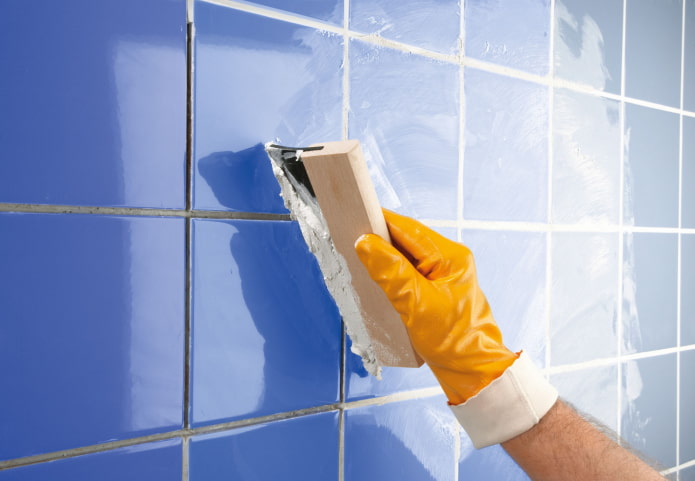
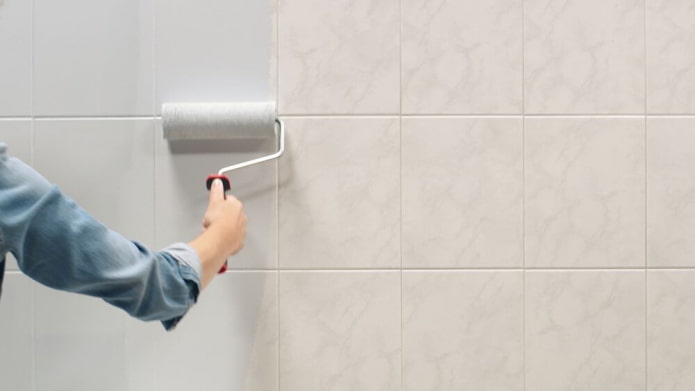

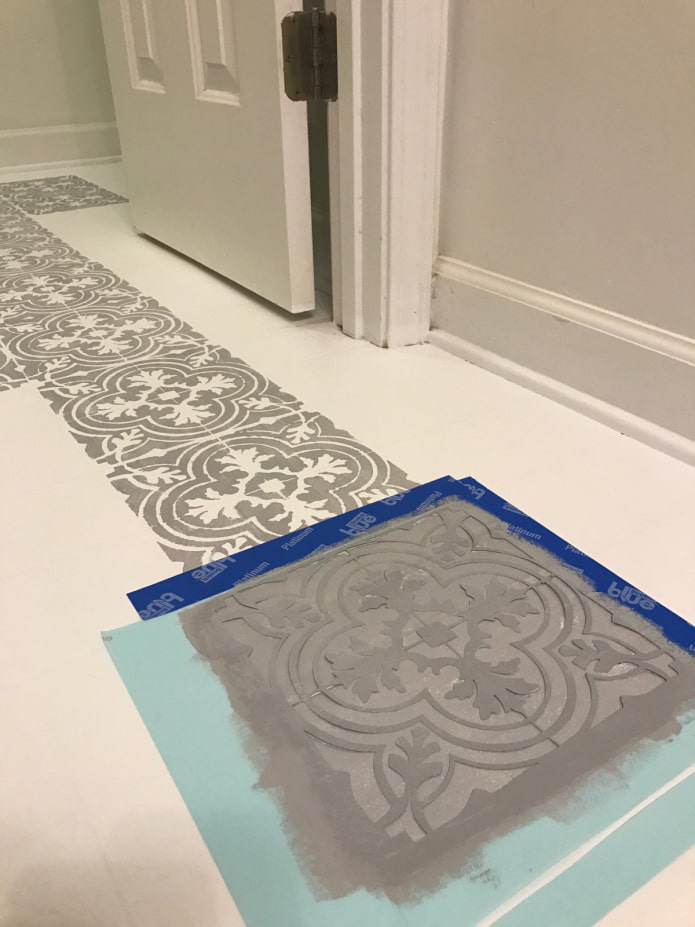
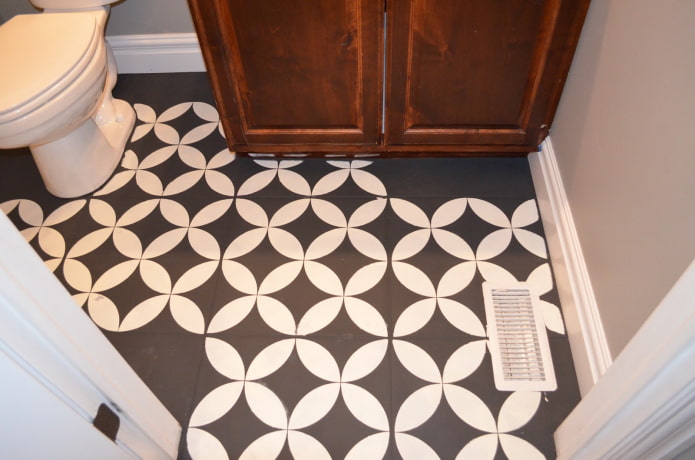
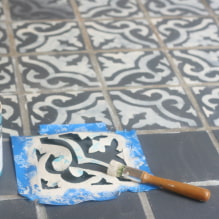
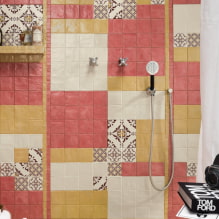
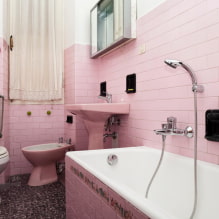
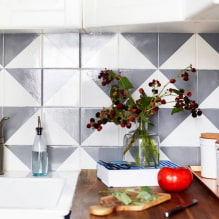
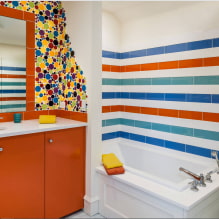
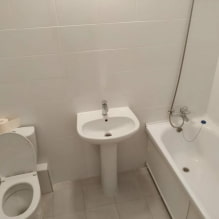

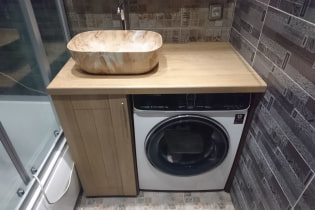 How to position the washing machine in a small bathroom?
How to position the washing machine in a small bathroom?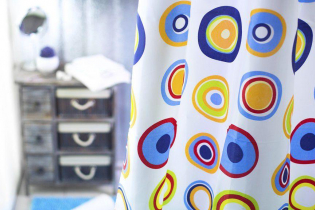 How to remove plaque from the bathroom curtain?
How to remove plaque from the bathroom curtain? 7 common mistakes in small apartment renovation that eat up all the space
7 common mistakes in small apartment renovation that eat up all the space Apartment layout: how not to be mistaken?
Apartment layout: how not to be mistaken? Wallpaper for the bathroom: pros and cons, types, design, 70 photos in the interior
Wallpaper for the bathroom: pros and cons, types, design, 70 photos in the interior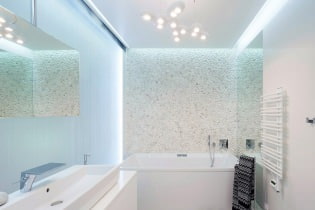 Modern bathroom interior: 60 best photos and design ideas
Modern bathroom interior: 60 best photos and design ideas